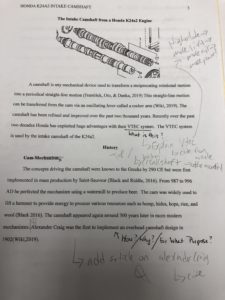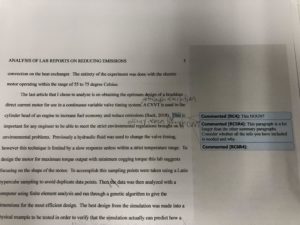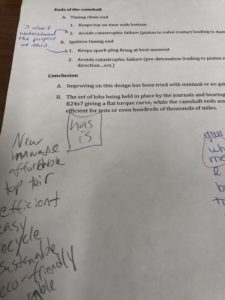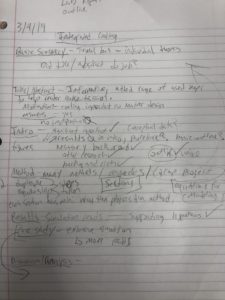Writing for engineering with Professor Rodwell has been my first writing class in four years. The introduction letter was a good assignment to help me with articulating myself properly. This semester I have enhanced my ability to write as it pertains to my field. Writing by itself was always a challenge for me, and during the more technical assignments this challenge turned to frustration as I struggled to articulate concepts I knew extremely well. Whenever I found myself stuck I referred to the course learning outcomes, I ensured that I had incorporated each aspect of these outcomes in each of my final drafts. It is evident when reading my earlier drafts of my assignments that they are not clear and concise. I have made advancements in all of the course learning outcomes in this class, each aspect was a major part of one or more of my assignments, these will be discussed in the order they appear on the syllabus. When writing my memo final draft, I only crossed off each critique that was written on my rough draft as I revised it. For my later assignments I wrote my revisions in pencil next to the original critique on my rough draft before writing my final draft.
The first aspect of the course learning outcomes I worked on this semester was rhetorical sensibility. This attribute demonstrates an ability to adapt to your audience in order to enhance communication through your writing, this is done largely by considering your audience you are writing for and the medium in which you choose to connect with your audience. For my memo assignment I made a mistake in how I was using my medium which was a memo format. Comments from professor Rodwell stated that I was focusing too much attention on the recommendations for fixing the problem being discussed while not giving a clear explanation of the scope of the problem. My discussion section took two revisions for me to grasp the main focus of a discussion section, these can be viewed below in Fig. 1 and Fig. 2.


By picking up on my mistakes from the first assignment, I was able to plan the following in a way to be sure that I was presenting information in the order which agreed with my medium. For the lab report analysis assignment, my rough draft lacked rhetorical sensibility when trying to convince my audience to share view of a lab report, providing more evidence was needed. For my technical description assignment, I was not clearly matching my images to the text I was using to describe my item. By first completing my rough draft and then adding updated images I was able to have a final draft that communicated better with the audience. The challenge with my group proposal project when it came to having rhetorical sensibility was being sure we did no leave out any aspect of the innovation and production process.
For all assignments I was able to increase my efficiency when reading, drafting, revising, editing, and self-assessment. Some assignments required more or one of these attributes than the other assignments, but for each all of these attributes were necessary. As show above for the memo assignment I was able to make the most of having multiple drafts. Self-assessment was difficult because I had never written a memo before. I started to use a strategy that I used for all the assignments after the memo assignment, this is marking my draft revisions with pencil on a hard copy before typing the revisions on my laptop. The lab report analysis assignment was much longer than the memo assignment, using my technique of marking my drafts with a pencil reduced the time it took to make my revisions. I used the extra time to read over my assignment again for self-assessment. The technical description required far more reading than the rest, because many simple concepts came together to form a more complex concept. I order to accomplish this I needed to constantly refer back to my on writing for context, often revising one paragraph required revising another paragraph that mentioned integral information. Below in Fig.3 I wrote my updates to critiques made by Prof. Rodwell. In order to keep track of my deliverable I would list other key points and thoughts that that particular update may affect in the rest of the paper, this made it possible to present something the reader could comprehend.

This process was efficient for the group proposal using google documents, but I was so efficient it was difficult to work on the most recent draft because it would be updated so frequently. At times I would be working on the project on the google document as someone else was also working on the project, this led to confusion about the direction of the paper and wasted time working on drafts that were never used.
The rhetorical situation was a key aspect for all assignments, it was important to keep in mind you audience because mostly that is what changed in the situation because it was a writing class so the medium was usually writing regardless of the style used to communicate. The only instance that writing was not the medium is for our group presentation. For my first assignment my audience was the president of City College. Even though I have never met Mr. Boudreau I was sure to keep my memo professional and concise but was still personal because it was written specifically for one person. The lab report analysis was also professional and concise but did not include any personal aspect. I considered my audience by clearly stating only relevant information needed to properly understand how I analyzed the lab reports. Below is an instance where I was unclear and providing too much information for the scope of the paper.

The technical description required a similar task, only including relevant information. What made the technical description different and more difficult was that all the information was more closely linked where in the lab report analysis the information was similar but not so interconnected. In order to retain my readers attention, I slowly worked my way to more advanced concepts throughout the paper.
This semester I was able to make great strides in my writing through reviewing my peer review with higher detail. We also had a collaborative assignment which helped me personally to work more cohesively with my younger peers. The first assignment gave me multiple peer reviews for my memo, this made it easy to find what writing aspects I lacked for that assignment. If I noticed an overlap in what aspect my memo needed, I was sure to include that in my revision.
My lab report analysis peer review was important to me, I already knew my background information needed updating, but was unsure how to include only what information was vital to the paper. For my technical description my peer review was of great help, not only because I received feedback, but I was also able to see my mistakes when reading my classmates approach to the assignment. The group proposal project was the largest amount of peer review I have had from an assignment in a long time, it was helpful to have others to help me think my ideas through before starting to write. Figure 5a , 5b, and 5c show an overlap in peer review, each critique came from a different classmate my memo was missing substance.




When completing my final drafts, I was able to review my entire process, when reflecting back I noticed each assignment had a different procedure. If approached properly from the beginning and planned correctly my final drafts could be duplicated with different subject matter in about half the time. I have successfully been able to explore effective writing using different multimodal composing techniques. For my memo assignment I chose to use an outline to organize my problems and recommendations in a way to communicate them to my audience. The lab report analysis required making a list of all the writing aspects that a lab report should include, I then read each report making notes one each of these aspects. If I particular aspect was missing, I would write down my thoughts on how that void affected my intake and retention of the information provided. The technical description assignment used a combination of list making and outlining, this is shown in Fig. 6. I used the outline to organize my overall thoughts while my lists insured I was making key points for my product. These techniques helped me to organize my thoughts and communicate them to the reader in a timely fashion, I used this extra time to read over my work from the beginning when making each revision.


For my introduction letter and memo, it was difficult for me to take a stance because I was still gaining confidence in my writing. As I progressed, I was able to practice taking my stance when writing my lab report analysis. For the technical description and group product it was necessary to take a strong stance. I did not take much of any stance in the first draft of the memo, it was difficult for me to criticize a new environment. I did take a stronger stance for my final draft, but my writing reflected that my confidence was clearly more for my recommendations than my belief there even was a significant problem. It was far easier to analyze the authors of the lab reports, this was because I had a clear outline on what was expected in the lab report from the text book. Fig. 7a shows my outline of what should be included in each report, Fig. 7b is how I analyzed on of my reports using this outline. My technical description was an easy stance to take because there were many reasons why the product, I chose was excellent. It was difficult to articulate this stance to my audience because it combined technology that is hundreds of years old with technologies that are only decades old.
Resources are the foundation for any piece of writing as it pertains to engineering. Except for the textbook all of my resources were technology based, I used a combination of the internet and online databases. When my writing required information that was not located on an online database, I would search the internet for a reputable source, mostly the sources from the internet were unusable. I did not use any online database for my memo assignment, this was a mistake. If I had used one or two resources outlining the problems around campus, I would have had much more information to include in my memo. I did use the internet and the textbook to find exactly what writing aspects my memo was expected to have. The lab report analysis relied on online databases for retrieving lab reports to analyze. I also used the textbook in order to outline what writing elements each report did or did not include. For my technical description I did not find any resources specifically pertaining to camshafts, so I instead searched the internet to find citable data for information I already knew to be true. Unfortunately, Wikipedia had the most concise information on the topic, this was a great staring point and helped me to start my paper. I was able to use the Wikipedia articles to comprehend the entire system I was trying to explain only one part of. Figure 8 shows my first thoughts on which direction I wanted to pursue for my technical description.

My best sources came from Academic Search Complete, every source contained in this database was credible. The search formatting of this database made it easy to find the specific information I needed for my technical description; this was important because I needed small amounts of information from many different sources. Once I began to write I was able to locate more sources which included the specific information I needed.
Throughout Professor Rodwells’ class all of the sources use practices were needed to write a piece that satisfied all the criteria from the assignment description and the grading rubric. For my memo assignment I was required to evaluate and summarize a problem that I noticed on campus. I came up with a solution by analyzing the problem and communicating my plan to integrate the solution. Even though this assignment lacked major writing techniques such as citing sources, paraphrasing, and quoting I was able to communicate to my audience using other practices. The lab report analysis used all the techniques from the memo but also heavily relied on citing sources, paraphrasing and quoting. I did use quotes in all drafts of my lab report analysis, but at times I did not include enough of my own writing around them. Figure 9 shows how Prof. Rodwell helped me to properly utilize a quote in my writing.

Summarizing each report without giving more background information was a challenge for this assignment. An even greater challenge was using all of my source use practices while retaining a report that was comprehensible. The technical description did not rely on as much summation of the source as a whole, but required me to layer a particular concept from multiple sources.
While completing my assignment for this class I often referred to the learning outcomes on the course syllabus for direction. I can confidently say I have completed each major goal for at least one assignment, for most of these goals I completed them during all assignments. Also I think that depending on the mode of writing the interpretation of these goals changed. Summarizing a problem as I did for the memo is a far different task then when summarizing a source like I did in other assignments. Also my use of resources was different for each assignment. Many of the goals overlapped, each assignment started with rhetorical sensibility, and regardless of where I was in my writing process I needed to keep this in mind. I have learned many new techniques this semester for enhancing my writing. Actively following the course learning outcomes helped me to find direction when learning the techniques I need to improve my writing and also to be able to adapt my writing for any situation I come across in the work field. I will definitely need to refer to the textbook used for this class and the work that I have completed’/ this semester when completing my first assignments when first entering the work force.



Recent Comments